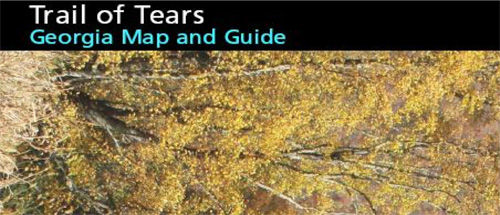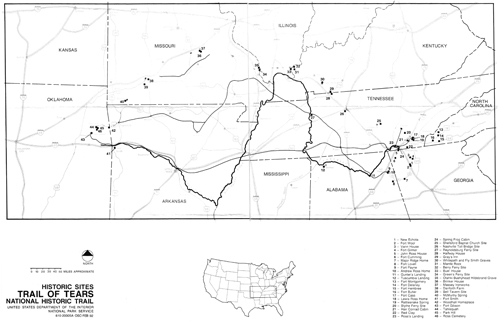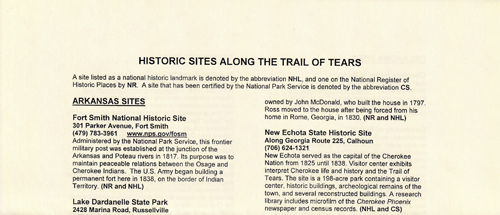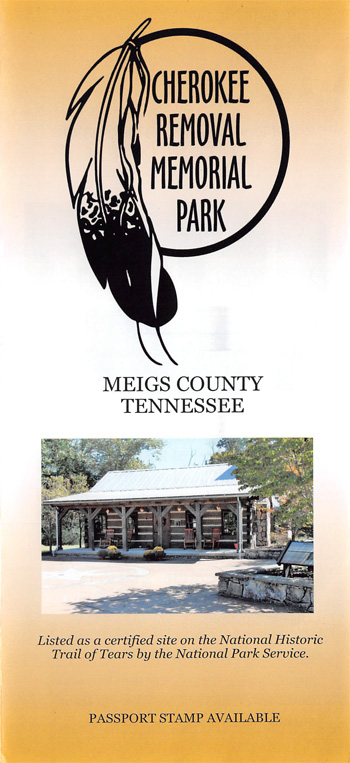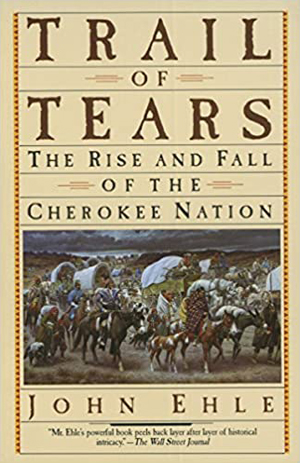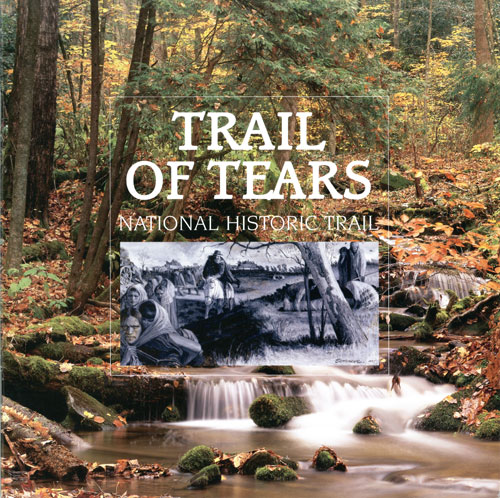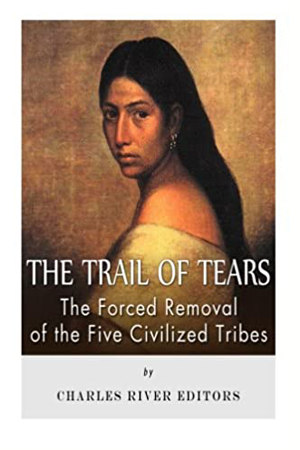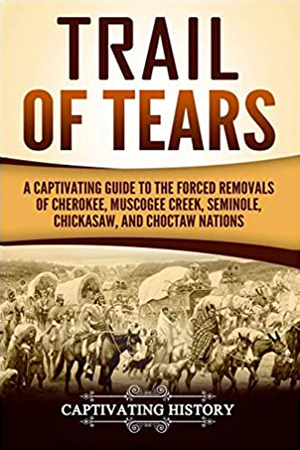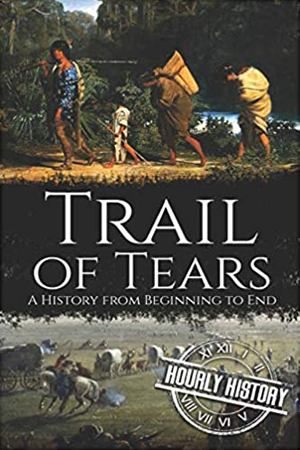|
Trail Of Tears National Historic Trail AL-AR-GA-IL-KY-MO-NC-OK-TN |
 |
 NPS photo | |
. . . the government might more mercifully have put to death everyone under a year or over sixty; rather it had chosen a most expensive and painful way of exterminating these poor people.
—Missionary Daniel Butrick
Cherokee Nation
A traveler through the southern Appalachians realizes that something is missing from the forested mountains and cascading streams. The people who once lived here no longer work the land or hunt the forests. Their spirits remain and their language is on the landscape, but most of them are gone. Where did they go? Do they survive? The answers are on the Trail of Tears.
In the 1600s about 25,000 Cherokee lived on lands stretching from the Ohio River to northern Georgia. But European diseases devastated the Cherokee throughout the 1700s, and by 1819 Americans' unquenchable thirst for land had whittled away Cherokee lands—down to 10 percent of their original territory.
Still, they endured. Cherokee Sacred Fire—rekindled each spring in the New Fire Ceremony and the source of every home fire—shone over a unified Cherokee Nation. Adopting many of the political and economic features of the United States, they drafted a constitution, established their own courts, and created a written language. As a symbol of their revival, their newspaper was named the Cherokee Phoenix, after the mythical bird reborn of fire. The Cherokee people had shaped a stable and prosperous life—one envied by their white neighbors.
The Removal Act
From the time Europeans arrived in the New World, they struggled with how to live alongside native people. In 1803 Thomas Jefferson became the first president to publicly support removing Indians, and for the next 25 years eastern tribes were forced west. Some of the Cherokee (known as the "Old Settlers") moved west on their own to distance themselves from the expanding American republic.
Events accelerated after Andrew Jackson was elected president in 1828. In 1830 Congress passed the Indian Removal Act, providing "for an exchange of lands with the Indians residing in any of the states or territories, and for their removal west of the river Mississippi." Meanwhile the state of Georgia, home to the Cherokee, passed laws prohibiting them from conducting tribal business, testifying against whites, and mining for gold.
The Cherokee Nation, though, had produced leaders well versed in the US legal system, leaders who fought back. In Worcester v. Georgia the US Supreme Court, headed by Chief Justice John Marshall, ruled in 1832 that the Cherokee held sovereign land rights. President Jackson openly dismissed the ruling. The Cherokee were running out of options.
The Gathering Storm
On the heels of the Indian Removal Act, government agents descended on the southeastern native peoples. One by one the tribes were removed. Agents coerced Choctaw chiefs in Mississippi to sign the first removal treaty, and in late 1831 the tribe was quickly moved to Indian Territory—present-day Oklahoma.
The government removed most Muscogee Creeks, many in chains, from Alabama and Georgia to Indian Territory by 1836. The Chickasaw, whose homeland had once stretched from Tennessee to Arkansas and Illinois, were taken away by the end of 1837. The Seminoles fiercely resisted removal from their Florida homeland but, after great losses in the Seminole Wars, some 4,000 people were deported to Indian Territory by 1842.
The Cherokee resisted removal and looked to their leaders to sway American political opinion. Still, 20 tribal members, led by Major Ridge and acting outside the authority of the Cherokee government, signed the Treaty of New Echota in 1835. The conditions for removal were set: In exchange for $5 million the tribe would relocate to Indian Territory. Though the majority of Cherokee protested the agreement, by May 1836 Congress made it law. The treaty gave the Cherokee two years to voluntarily move.
Cherokee Trail of Tears
Most Cherokee refused to recognize the Treaty of New Echota; few had moved after two years. In the spring of 1838, 7,000 soldiers under Gen. Winfield Scott moved against the Cherokee Nation. The removal effort began in Georgia, where Cherokee families were uprooted and driven—sometimes at bayonet point—to "round-up" camps, then concentrated in larger removal camps.
In June the army loaded Cherokee onto flatboats that traveled the Tennessee, Ohio, Mississippi, and Arkansas rivers to Indian Territory. The first boat reached its goal in 13 days, but desertions and fatalities plagued the next two groups. Diseases raged through the cramped, poorly-supplied boats.
To save his people, Principal Chief John Ross petitioned General Scott to let the Cherokee control their own removal. Ross organized detachments of about 1,000 each, and the Cherokee traveled by foot, horse, and wagon for 800 miles, taking up to eight months to reach Indian Territory. Despite prearranged supply points, they suffered terribly during the hard winter. Of about 15,000 Cherokee forced from their homes, many hundreds died in the camps or on the journey. The Cherokee Nation remained alive though, in the spirits of the people and in the ashes saved from the Sacred Fire they carried along the trail.
A Nation Renewed
Weak and traumatized, 17 detachments of Cherokee arrived in Indian Territory in 1838 and 1839. The treaty strife and the harsh removal had also divided the Cherokee into three factions: pro-treaty, anti-treaty, and the "Old Settlers."
Despite the political discord, the Cherokee reconstructed their lives. In September 1839 delegates signed a constitution. The tribe reelected John Ross as Principal Chief and Tahlequah became the Cherokee capital. In 1844 the Cherokee Supreme Court building opened its doors. The Cherokee Advocate, a bilingual newspaper, began publication. By 1846 the three factions had signed a treaty that addressed many of their differences. The Sacred Fire of the Cherokee Nation burned again.
Meeting other challenges as they rebuilt their nation, the Cherokee proved resilient in the ensuing years. Today the Cherokee and other removed tribes endure as vigorous Indian nations. The Trail of Tears story is one of racial injustice, intolerance, and suffering. But this is also a story of survival, of a people thriving in the present while remembering the past—not only in Oklahoma, but in the homelands of southern Appalachia.
Dwindling Cherokee Lands
1721 The Cherokee sign the first of several treaties that, over the next 70 years, force them to cede over half their lands.
1791 (July 2) The Treaty of Holston places the Cherokee under US protection.
1828 The discovery of gold in northern Georgia leads to the "Georgia Gold Rush" the following year, much of it on Cherokee lands.
1830 (May 26) Congress passes the Indian Removal Act; President Andrew Jackson signs it into law two days later.
1832 Lotteries are held for appropriated Cherokee lands in Georgia.
1832 (March 3) In Worcester v. Georgia the US Supreme Court confirms that the Cherokee Indians are a nation holding distinct sovereign powers.
Southeast Indian Removal
1835 (Dec. 29) Twenty "treaty party" leaders sign the Treaty of New Echota, which leads to Cherokee removal.
1838 (May) Cherokee are forcibly removed from their homes and marched to nearby temporary camps and forts.
1838 A group of North Carolina Cherokee avoid removal because they live on land ceded to them by earlier treaties. These Cherokee are the basis for today's Eastern Band of Cherokee Indians.
1838 (Aug. 23) Cherokee Hair Conrad leads the first land route detachment out of Fort Cass, Tennessee. Twelve more detachments depart over the next two months, most traveling by the northern route.
1838 (Sept. 28) Cherokee leader John Benge leads a detachment out of Fort Payne, Alabama.
1838 (Oct. 11) John Bell, a white man married to a Cherokee woman, leads 660 pro-treaty Cherokee to Indian Territory.
1839 (Jan. 4) The first land route detachment, led by Cherokee Elijah Hicks, arrives in Indian Territory; final detachments arrive in late March.
1839 (Sept. 6) Cherokee delegates sign a constitution for the reunited Cherokee Nation.
1987 Congress establishes the Trail of Tears National Historic Trail. In 2009 more routes are added.
One will not hear the anguished voice of a forgotten and broken people. Instead one might hear the pride of people who faced overwhelming adversity and persevered.
—Cherokee Nation
RETRACE THE TRAIL
 (click for larger map) |
The sites of Trail of Tears National Historic Trail, stretching 5,043 miles across nine states, together form a journey of compassion and understanding. The National Park Service administers the trail in partnership with the Trail of Tears Association; the Cherokee Nation; the Eastern Band of Cherokee Indians; federal, state, county, and local agencies; interested groups; and private landowners. Trail sites are in private, municipal, tribal, federal, or state ownership. Please ask for permission before visiting any trail sites on private lands and check with public sites for visiting hours and regulations. At www.nps.gov/trte click on Plan Your Visit for in-depth travel planning.
George Murrell married a Cherokee woman and journeyed with her to Indian Territory. In 1845 he built a house near Tahlequah.
Elkhorn Tavern (reconstructed) at Pea Ridge National Military Park, Arkansas, witnessed thousands of Cherokee passing by.
Camp Ground Cemetery near Anna, Illinois, is said to contain the graves of Cherokee who camped nearby.
Hikers can retrace a portion of the original northern route where it winds through the Crabb-Abbott Farm near Grantsburg, Illinois.
Blocked by the icebound Ohio, some 1,700 Cherokee camped near Mantle Rock in Livingston County, Kentucky.
Cherokee James Vann built his house near what is now Dalton, Georgia.
Brainerd Mission was a stopping point and hospital during removal. For many Cherokee, its cemetery is their final resting place.
Tennessee's Red Clay State Historic Area near Chattanooga has a reconstruction of the Cherokee Council House.
REMOVAL CAMPS
After being forcibly removed from their homes in Georgia, Alabama,
Tennessee, and North Carolina, most Cherokee are moved into 11 removal
camps—10 in Tennessee and one in Alabama. There they await the
start of an 800-mile journey.
FORT CASS
Location: Present-day Charleston, Tennessee. From August 23 to December
5, 1838, 10 detachments totaling 9,302 Cherokee are marched from Fort
Cass toward Indian Territory.
BLYTHE FERRY
Location: Meigs County, Tennessee. Nine detachments with more than 9,000
Indians cross the Tennessee River.
ROSS'S LANDING
Location: Present-day Chattanooga, Tennessee. From June 6 to June 17,
1838, three detachments are forced to leave their homeland for Indian
Territory.
VANN'S PLANTATION
Location: Present-day Wolftever Creek, Tennessee. Two detachments
totaling 1,642 Cherokee leave in September 1838 bound for Indian
Territory.
BELL ROUTE
Starting from Fort Cass on October 11, 1838, John Bell of the Treaty
Party leads 660 Cherokee, ending at present-day Evansville, Arkansas.
WATER DETACHMENTS
Cherokee removals from Ross's Landing and Fort Cass include four water
route detachments that prove to be punishing for the Indians: 3,103
depart; 2,273 arrive at Mrs. Webber's Plantation (near present-day
Stilwell), Fort Coffee, Lee's Creek (near Stilwell), and Illinois
Campground (near Tahlequah).
BENGE ROUTE
Starting from Fort Payne, on September 28, 1838, Cherokee leader John
Benge escorts 1,079 Cherokee toward present-day Stillwell, Oklahoma.
TRAIL'S END
The last detachment arrives in Indian Territory on March 24, 1839. The
Cherokee are promised subsistence rations through March 1, 1840, in
compliance with the Treaty of New Echota.
TAHLEQUAH, OKLAHOMA
The Cherokee National Council designates Tahlequah as the capital of the
Cherokee Nation on October 19, 1841.
Source: NPS Brochure (2012)
|
Establishment Trail Of Tears National Historic Trail — December 16, 1987 |
For More Information Please Visit The  OFFICIAL NPS WEBSITE |
Brochures ◆ Site Bulletins ◆ Trading Cards

Documents
Alabama Collection Camps, Forts, Emigrating Depots and Travel Routes Used During the Cherokee Removal of 1838-1839 (Lamar Marshall, Larry Smith and Michael Wren, March 2009)
Cherokee Removal From Georgia: Final Report (Sarah H. Hill, December 2005)
Comprehensive Management and Use Plan, Trail of Tears National Historic Trail (September 1992)
Comprehensive Management and Use Plan Map Supplement, Trail of Tears National Historic Trail (September 1992)
Coveted Lands: Agriculture, Timber, Mining, and Transportation in Cherokee Country Before and After Removal (©Vicki Bell Rozema, PhD Thesis University of Tennessee, Knoxville, May 2012)
Exhibit Panels: David Crockett State Park (undated)
FY 2010 Superintendent's Annual Report. National Park Service, National Trails Intermountain Region, Santa Fe, NM Published Report-2185941 (Aaron Mahr, October 2011)
Historic Preservation Report: James Brown House (John A. Scott, FY 2007)
Historic Structure and Cultural Landscape Report: Chieftains Museum/Major Ridge Home, Trail of Tears National Historic Trail (Glenn D. Simpson, Mark L. Mortier and Steve Burns-Chavez, 2007)
Historic Structure Report: Snelson-Brinker House (MTSU Center for Historic Preservation, October 2017)
Historical and Interpretation Study: The Trail of Tears National Historic Trail and the Tennessee, Wheeler and White River National Wildlife Refuges (Thomason and Associates, September 2007)
Junior Ranger Program, Trail of Tears National Historic Trail (2016; for reference purposes only)
Myth and History: The John Ross House through Time (William J. Bishop, April 2007)
National Historic Trail Feasibility Study Amendment and Environmental Assessment, Trail of Tears National Historic Trail Alternate Routes (November 2007)
National Trails Intermountain Region News
March 2013 • October 2013 • April 2014 • October 2014 • March 2015 • October 2015 • April 2016 • October 2016 • April 2017
National Register of Historic Places Nomination Form
Cherokee Trail of Tears in Missouri, 1837-1839 (Tiffany Patterson, December 2013)
Newsletter (Trail of Tears National Historic Trail)
2023: Spring
Newsletter (Trail News: Newsletter of the Trail of Tears Association)
2002: Fall
2006: Spring
2009: Spring
2013: Fall
2022: Spring
North Alabama's Tuscumbia, Courtland, and Decatur Railroad and Its Role During Cherokee Emigration/Removal Beginning in 1837 (Marty King, Lamar Marshall and Larry Smith, June 15, 2009)
Proceedings: Trail of Tears Symposium (April 17-18, 1996, North Little Rock, Arkansas)
Proceedings: Eighth Annual Trail of Tears Association Conference & Symposium (Jerra Quinton, ed., October 6-9, 2003, Cherokee, North Carolina)
Proceedings: Ninth Annual Trail of Tears Association Conference & Symposium (Jerra Quinton, ed., October 25-28, 2004, Catoosa, Oklahoma)
Restoration Guide for Historic Log Buildings on the Trail of Tears National Historic Trail (Middle Tennessee State University Center for Historic Preservation, February 2015)
Restoration Guide for Historic Masonry Buildings on the Trail of Tears National Historic Trail (Middle Tennessee State University Center for Historic Preservation, January 2016)
Rivers, Rails & Roads: Transportation During the Cherokee Removal, 1837-1839 (Middle Tennessee State University Center for Historic Preservation, November 2020)
Running Waters (W. Jeff Bishop, June 2008)
The North Little Rock Site on the Trail of Tears National Historic Trail: Historical Contexts Report (Amanda L. Paige, Fuller L. Bumpers and DAniel F. Littlefield, Jr., Augsut 4, 2003)
The Removal of the Creek Indians from the Southeast, 1825-1838 (©Christoopher D. Haveman, PhD Thesis Auburn University, August 10, 2009)
The Trail of Tears in Southern Illinois (undated)
The Trail of Tears in Tennessee: A Study of the Routes Used During the Cherokee Removal of 1838 (Benjamin C. Nance, 2001)
Trail of Tears (NPS and Cherokee Nation, Date Unknown, Duration: 22:56)
Trail of Tears National Historic Trail (NPS, 2013, Duration: 26:26)
Books

trte/index.htm
Last Updated: 13-Nov-2023



